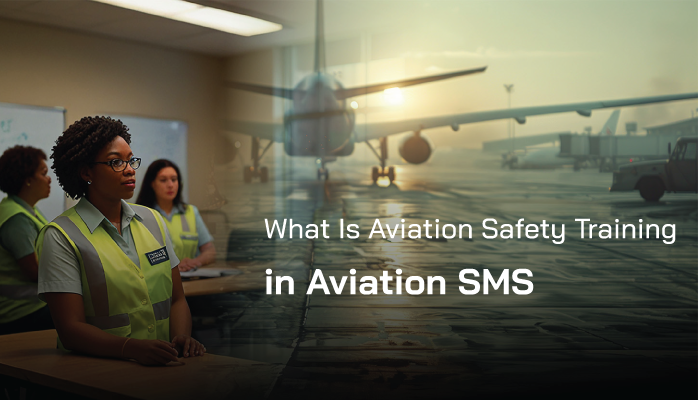What Defines Aviation Safety Training

Aviation safety training and education are essential building blocks to develop performant safety cultures. This should be among the first elements to scrutinize whenever employees are involved in safety accidents or incidents.
Safety training and education falls under the Safety Promotion component in the 4 Pillars of Aviation SMS. Safety training can make or break the successful performance of an SMS program for:
- Meeting safety goals and objectives;
- Sustaining continuous improvement of the SMS;
- Ensuring return on investments for aviation SMS;
- Ensuring consumer confidence in the company (i.e., lack of accidents);
- Developing a mature safety culture; and
- Ensuring compliance is met.
Safety training is not a simple topic though. The aviation industry is littered with so-called “training courses” that offer very little substance.
Related Articles on Aviation SMS Training and Education
- 4 Pillars | 10 Things You Need to Know About Aviation Safety Training
- 3 Biggest Aviation Risk Management Training Mistakes
- Most Common Misconceptions About Aviation Risk Management Training
Here are the important elements of safety training and education in the aviation industry
Signs of Good Aviation Safety Training
Not all aviation risk management training is created equal. The quality of aviation safety training ranges as much as training price tags. And more expensive does not always equal better quality either. Getting good aviation SMS training is about knowing what to look for.
You can generally get a good indication of the quality of a training course from the course syllabus. Here are several elements of training that indicate a quality course:
- Pre training assessments;
- Practical application of ideas rather than definitions or concepts;
- Topics that are relevant to your aviation SMS;
- Hands-on training, stresses “doing” rather than “listening”;
- End of course assessments; and
- Take home materials.
The above points are all geared towards one thing: operational risk management.
The idea of training for operational risk management is very different from most risk management training courses, which often fail to move beyond lecture-based, conceptual models of risk.
Such training courses are a waste of money, as employees will forget most of the training by the time they fall asleep at night.
Signs Your Employees Need More Safety Training

Safety training needs to happen at every level of an organization. Front-line employees, safety management, and upper management all need to understand their role in the risk management process.
Oftentimes, the effectiveness of SMS training will depend on safety management’s ability to understand what safety training is actually needed. How much money is wasted every year on redundant, irrelevant, or superfluous safety training?
Make sure risk management training counts – here are several indicators that more SMS training is needed:
- Employees have not received SMS induction training (initial SMS training);
- Front-line employees have not received specific risk management training, such as understanding the difference between hazards, risks, and control measures;
- Safety management team gets confused or makes repeat mistakes during risk assessments and analysis;
- Department heads’ corrective actions and preventive actions do not reflect the standards of goals and objectives;
- Previous safety training has not featured pre and/or end-of-course assessments;
- Safety performance has plateaued; or worse yet,
- SMS performance has declined or ceased.
Monitoring quality safety data metrics, such as aviation leading indicators, is a great way to monitor where more training is needed.
Related Articles on Aviation Safety Performance Monitoring
- How to Monitor Aviation SMS' Safety Culture Performance
- My Safety Score - What's Yours? Aviation SMS Performance Monitoring
- How to Be Compliant With ICAO Safety Performance Monitoring and Measurement
Why Safety Training Fails
The fact is that aviation SMS training does not guarantee anything. The training program might be a complete flop. This is bad financially, for safety, and for employee confidence in the SMS. Here are the most common mistakes made in training courses:
- Nothing in it for the employees – what incentives do they have to pay attention or care?
- Training blindness due to same training materials being used over and over;
- Poorly qualified SMS trainer;
- Safety training materials are boring;
- Too much time wasted on "off-topic" conversations;
- Job-duty-related distractions pull students from class, which affects everyone;
- Poor representation (attendance) or lack of visible support from upper management; and
- SMS training is not personally relevant to employees’ operational environment.
The above points are concluded by one feeling employees have about SMS training: they don’t care about it.
What to Expect From Aviation Safety Training

Don’t be fooled by false expectations about safety training. It may or may not be good for the SMS. The success of training depends on many factors, including:
- Existing safety culture;
- How hands-on training materials are;
- Historical precedent for safety training; and
- The quality of the training course, such as how interesting and stimulating the course is.
When the above requisites are not met for delivering high-quality safety training, safety managers are often stuck with a bloated opinion of the preparedness level of the organization – the training misconceptions is that:
- The safety training will improve safety performance;
- Knowing the ideas and concepts will result in improved safety behavior; and
- The risk management training was a good use of resources.
The above can be true, but training by no means guarantees it. Only good safety training provides these benefits.
Related Articles on Aviation Safety Training
- How Aviation Safety Articles Satisfy Recurring SMS Training Requirements
- Aviation SMS Training - Meet Your Objectives Easily - With Templates
- Why Employees Can’t Stand Aviation SMS Training
Final Thought: Important Topics for Aviation Safety Training
Several SMS topics require more attention than others. Some of the core topics that should be trained are:
- Safety awareness;
- Safety communication;
- Safety accountability;
- Hazard identification;
- Hazard reporting processes; and
- The full risk management cycle.
The above points should give employees a solid foundation in the effective safety culture needed for a successful aviation safety management system.
Automated Aviation SMS Training
Aviation service providers do not need to spend considerable sums delivering initial SMS training to line employees. Most employees can access computers in our modern age. The most convenient, cost-effective SMS training is computer-based training.
Here are some training videos to supplement your initial aviation SMS training. Make sure you document which employees have participated in SMS training and the dates of their participation. While certificates are a nice touch, I have never seen a requirement that aviation service providers deliver Certificates of Completion to participants.
If you want to monitor SMS training automatically, SMS Pro has tools to deliver, track, and monitor the effectiveness of SMS training. Furthermore, SMS Pro will generate certificates, if this is a requirement.
SMS Database to Monitor Effectiveness of SMS Training
How does the accountable executive know that SMS training budgets are providing a return on investment? Track your SMS training and the effectiveness of your training using a low-cost, commercially available SMS database. Every SMS Pro product has this capability. Watch these videos, and if you want to see more, sign up for a free demo.
Ready to See SMS Pro Live and Ask Questions? No obligation and we won't continue to hassle you.
Last updated January 2025.






